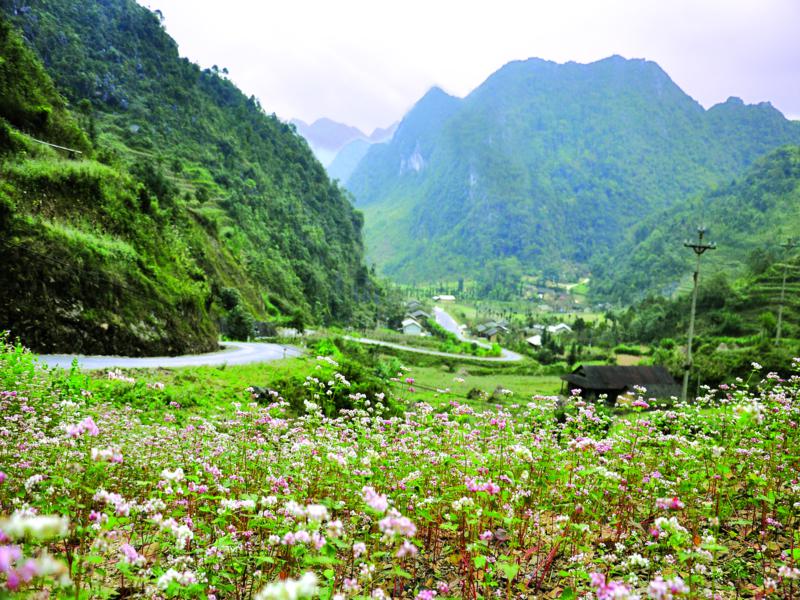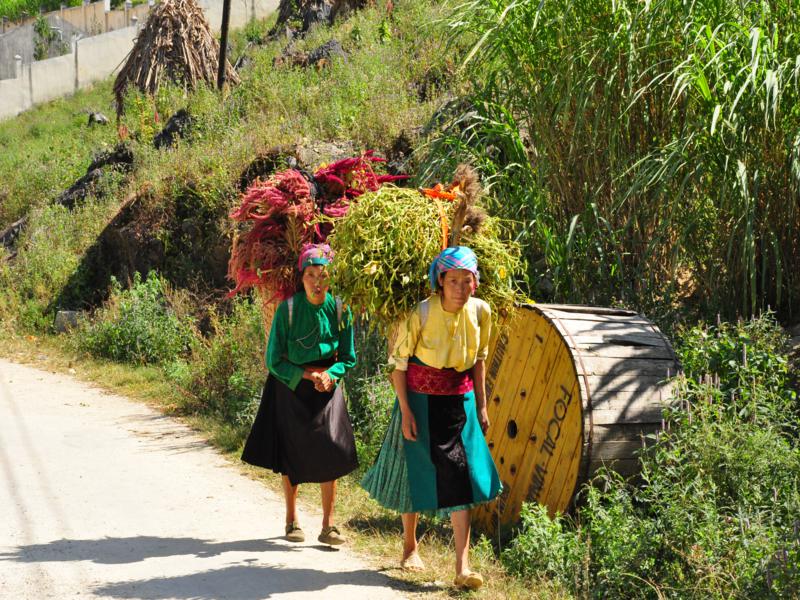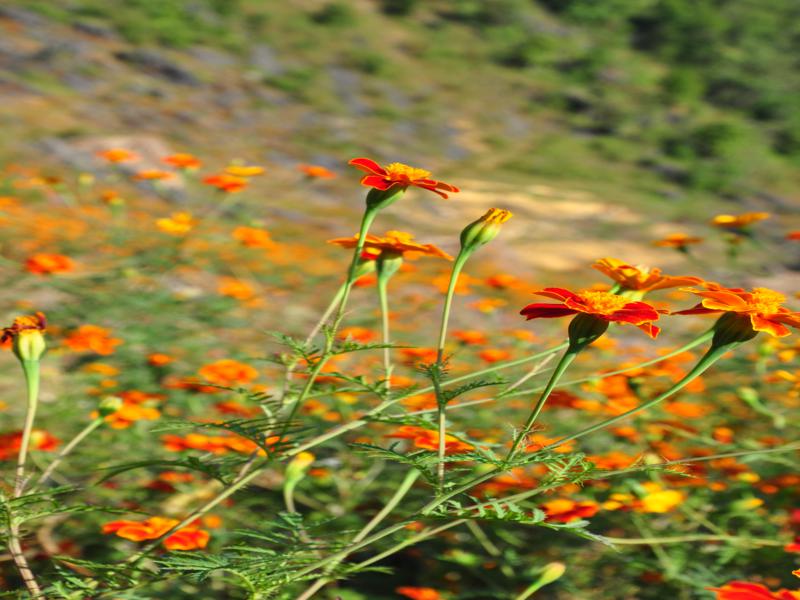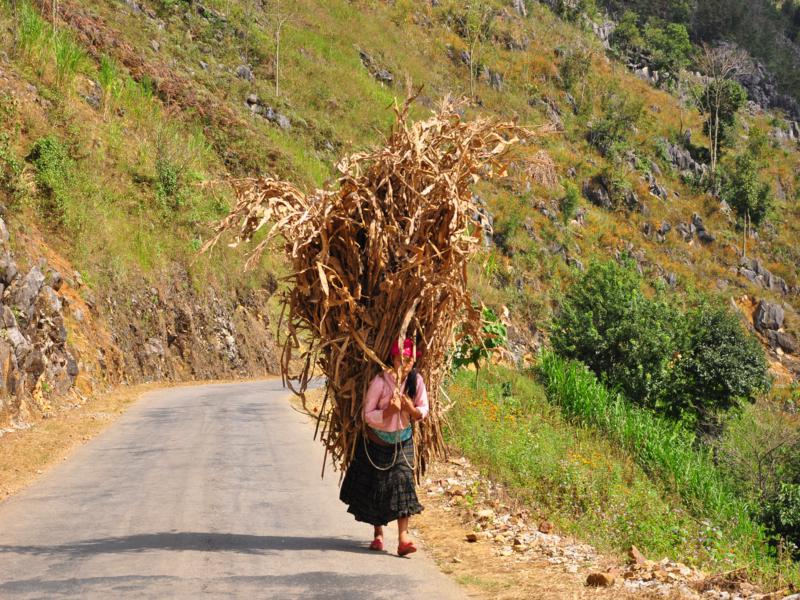Post :Son Nguyen.Image:Son Nguyen, Lam Thanh
In that faraway land, where the rocks are full of thorns and life is full of hardship, the flowers are in full bloom. It is not clear since when, but autumn has become the rendezvous season for wanderers who love to wander with the clouds, wind, and sky of this place.
In November, the corn stalks buried in the rocks give way to another brilliant flower, buckwheat. From Sung La, the purple-pink buckwheat fields take me from one dream of floating flowers to another. Since when, I have loved these late autumn days in Ha Giang so much that every year I pack my backpack and set off, drifting in the seasons of beautiful flowers blooming on the cat-ear rocks.

The first time I passed Sung La, I was particularly impressed by the valley scenery that suddenly appeared after the hairpin bend. From above, I could see rows of sturdy cypress trees, stretching high into the sky and carpets of brilliant flowers. The valley was immersed in the fragrance of roses. The roofs of the houses lay still in the sun, the low stone fences, the rose trees in the garden were full of fruit and firewood was piled in the kitchen corner, ready for the upcoming cold winter. In the attic, the color of corn mixed with the color of dried soybeans. A Mong girl sat weaving at the loom, although she could not speak much Kinh, she was still willing to offer her friend a bowl of cool water to quench her thirst at noon. The children, some older, looked after the others, playing on the steps, their black eyes flickering as they watched the strange guests.

The Mong people in Sung La grow buckwheat and rapeseed on high hills, and corn and rice on flat land at the bottom of the valley. Mixed in with the green of corn and rice are the purple of buckwheat flowers and the yellow of the sun, the dark green of the rows of cypress trees standing tall in the sky. The corn plants growing among the rocks have been harvested and brought home. Corn is the main food source for the people on this land. Corn is used to make wine, corn is used to make cakes, and cornmeal. Corn cobs and corn stalks are dried and used for cooking. The rocky land cannot grow many types of crops. Corn plants are grown in the holes in the rocks.

Every day, the Hmong people have to carry baskets of soil from far away and stuff them into each rock cavity, using rocks to keep the rainwater from washing away the soil, then put in the corn seeds. The green corn stalks grow up and stretch out in the layers of gray rocks, just like life still rises up in the barren land every day. Now I understand why the Lo Lo, Mong and Dao people all wear colorful scarves and charming skirts of many colors. Their green and pink shirts stand out against the gray cat-ear rocks. Their footsteps are quick across the highlands.

Passing the corn season, the road to Sung La is filled with carpets of buckwheat flowers. The pale purple-pink petals make the hearts of many travelers passing by flutter. The fragile buckwheat is planted after each rice crop in September every year. Previously, the seeds of the flower were used to make cakes, but now they are mostly used as animal feed. Young buckwheat leaves are used as a green vegetable, when boiled they are sweet and cool, only the flowers are not used for anything, but they make many passersby excited. Buckwheat becomes the flower of autumn, when the slanting sunlight still spreads honey across the valley and the weather is not too cold, we return to Sung La, to sit by the stone fences and indulge in the fairyland.

Buckwheat is grown all over Ha Giang, from Sung La to Lung Cu and then Dong Van. Mixed with the purple color is the pure white color of the Xuyen Chi patches blooming along both sides of the road from Yen Minh to Dong Van, Meo Vac. Wildflowers are always present on every road, swaying in the morning mist, resilient in the frost and radiant in the sun. White flowers bloom on the mountain slopes, blooming on the most dangerous mountain crevices. Mixed with that wild flower is another beautiful flower that only shows its brilliant colors in the late autumn days.

My friends came to Ha Giang because of the call of buckwheat flowers, a flower that is only planted after the rice crop and blooms a month later. As for me, I came to Ha Giang because of the wild daisies, because of the lovely flower patches that bloom on the cat-ear rocks. Wild daisies bloom brilliantly on every path. The flowers are mixed with corn stalks, reaching out to catch the sunlight. The flowers decorate the winding road through the mountains and forests, stirring the hearts of passersby.
The flower patches are like the smiles of Mong girls in the bustling harvest days, gracefully swaying with the early winter winds. The wild chrysanthemums are graceful yet also strong, the color of the flowers, even though they have withered, still retains the orange-red hue, the flower branches, even though picked and brought home, are not crushed, just like the hard-working people of this difficult land. In the dry late autumn sun, the wild chrysanthemums bloom their brightest smiles, before winter comes and the cold wind returns.

Late autumn, I brought back my memories of Ha Giang. There, among the rugged, shimmering rocks in the sunlight, somewhere in my garden, orange flowers were blooming for a new season of fruit. There, along with the honey-yellow sunlight, were the colors of the dried corn stalks, the newly harvested corn crop, and the golden soybeans.
There, the four seasons are four different beautiful paintings and each season makes visitors not want to leave. There, it is in the most brilliant golden autumn with purple buckwheat flower carpets floating and brilliant wildflower slopes on the precarious mountain slopes.


































